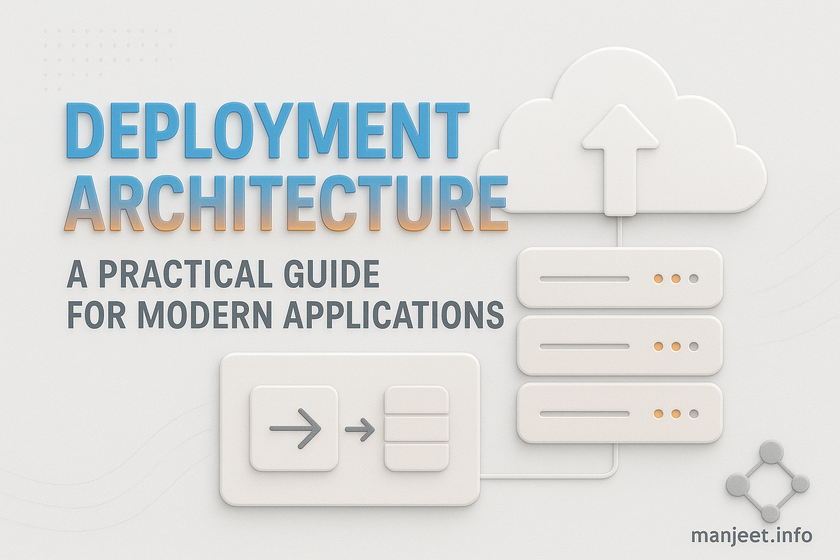When you develop an application, half is in the code. The actual difficulty comes into play when you have to install that application in a stable, reliable, and safe manner. That is where deployment architecture enters the picture.
Put, deployment architecture determines how the parts of your application are organized, their location, and the associated interactions that occur when deployed to production.
What you need to imagine is the design of a city: the things (services), the roads (networks), and the power (infrastructure) cannot be anything; it has to be planned as well, or the town will not be a functioning unit.
Why Deployment Architecture Matters
A poorly planned deployment can lead to:
-
Downtime during peak traffic
-
Security vulnerabilities
-
Cost overruns due to inefficient infrastructure
-
Poor performance and unhappy users
On the flip side, a well-thought-out deployment architecture ensures:
- High availability
- Scalability on demand
- Cost optimization
- Smooth developer and user experience
Key Components of Deployment Architecture
1. Application Components
Your app may consist of:
-
Frontend (what the users see - web, mobile, UI layer)
-
Backend (APIs, business logic)
-
Databases (SQL/NoSQL)
-
Caching systems (Redis, Memcached)
-
Message brokers/Queues (Kafka, RabbitMQ)
These must be strategically placed to optimize performance.
2. Infrastructure Setup
There are multiple ways to host and deploy applications:
-
On-Premise Servers: You own and manage physical servers. Rare today, but still used in sensitive industries.
-
Cloud Providers (AWS, GCP, Azure, DigitalOcean, etc.): Flexible, scalable, and pay-as-you-go.
-
Hybrid/Multicloud: A mix of on-premise and cloud, often used for compliance and resilience.
3. Deployment Models
Different architectures suit different use cases:
-
Single-Server Deployment: Great for small apps, testing, or MVPs. Not scalable.
-
Three-Tier Architecture: Separates frontend, backend, and database layers. Improves performance and maintenance.
-
Microservices Architecture: Breaks apps into independent services (e.g., payments, search, user management). Scalable and resilient, but adds complexity.
-
Serverless Deployment: No servers to manage. You just run functions (AWS Lambda, Google Cloud Functions). Best for event-driven workloads.
-
Containerized Deployment: Using Docker + Kubernetes. Ensures consistency across environments and auto-scales efficiently.
Deployment Strategies
Once your architecture is in place, you need a strategy for releasing updates safely. Some common approaches are:
-
Recreate Deployment: Shut down the old version and start the new one. Simple, but causes downtime.
-
Rolling Deployment: Update instances one by one until all run the new version.
-
Blue-Green Deployment: Run two identical environments (Blue = current live, Green = new version). After testing Green, switch traffic over instantly. If issues occur, roll back to Blue.
-
Canary Releases: Roll out the new version to a small set of users first, then gradually expand to everyone.
Among these, Blue-Green Deployment is one of the most popular because it ensures:
-
Zero downtime
-
Safer releases
-
Instant rollback options
Example Blue-Green Deployment Flow
Imagine you're running an e-commerce site.
-
Blue environment = current live version.
-
Deploy new code to the Green environment.
-
Test Green while Blue still serves users.
-
Switch the load balancer to route all traffic from Blue → Green.
-
If something breaks, revert to Blue instantly.
This approach keeps your users happy while you innovate.
4. Networking & Security
-
Load Balancers distribute traffic across servers.
-
CDN (Content Delivery Network) reduces latency.
-
Firewalls & WAF (Web Application Firewall) protect from attacks.
-
Zero Trust Security Models are becoming standard.
5. Monitoring & Observability
Deployment doesn't end after "pushing doesn't exist." You need:
-
Logging (ELK S" ack, Loki)
-
Monitoring (Prometheus, Datadog, Grafana)
-
Alerting (PagerDuty, Opsgenie)
This helps detect and fix issues before they affect users.
Example Deployment Architecture
Let's say you're deploying your application:
-
Frontend hosted on a CDN like Cloudflare.
-
Backend APIs deployed in containers (Kubernetes).
-
Database (PostgreSQL) managed via AWS RDS.
-
Caching with Redis.
-
Queueing system with RabbitMQ for order processing.
-
A load balancer distributes traffic across multiple API servers.
-
Monitoring with Prometheus + Grafana.
This setup ensures the app stays fast, secure, and scalable even during Black Friday traffic surges.
Best Practices for Deployment Architecture
-
Automate everything (CI/CD pipelines)
-
Keep infrastructure as code (Terraform, Ansible)
-
Plan for failure (auto-healing, backups, failover)
-
Optimize costs (right-size servers, use spot instances)
-
Prioritize security (encryption, IAM policies, secrets management)
Final Thoughts
There is no such thing as a deployment architecture. How it is appropriately configured varies based on your application's size, the number of users, compliance requirements, and budget. Be simple initially, and go complex as your product and traffic increase.
A resilient, scalable, and secure application is based on a well-designed architecture backed by innovative deployment strategies such as Blue-Green Deployment. It is probably the unsung hero in any seamless user experience.
Read also How to Create a Web Server and Deploy a Web Application: Step-by-Step Guide for Beginners.
